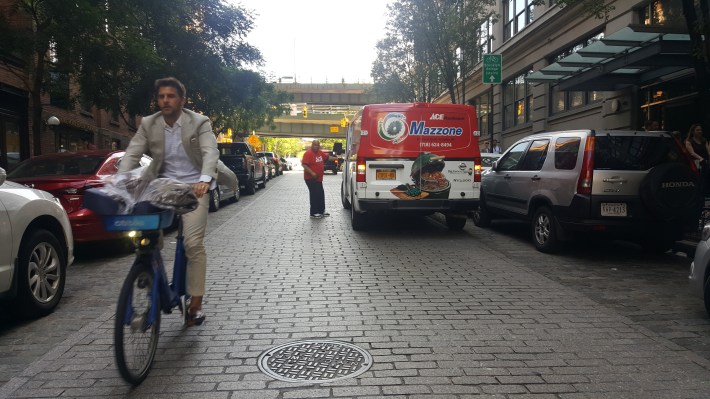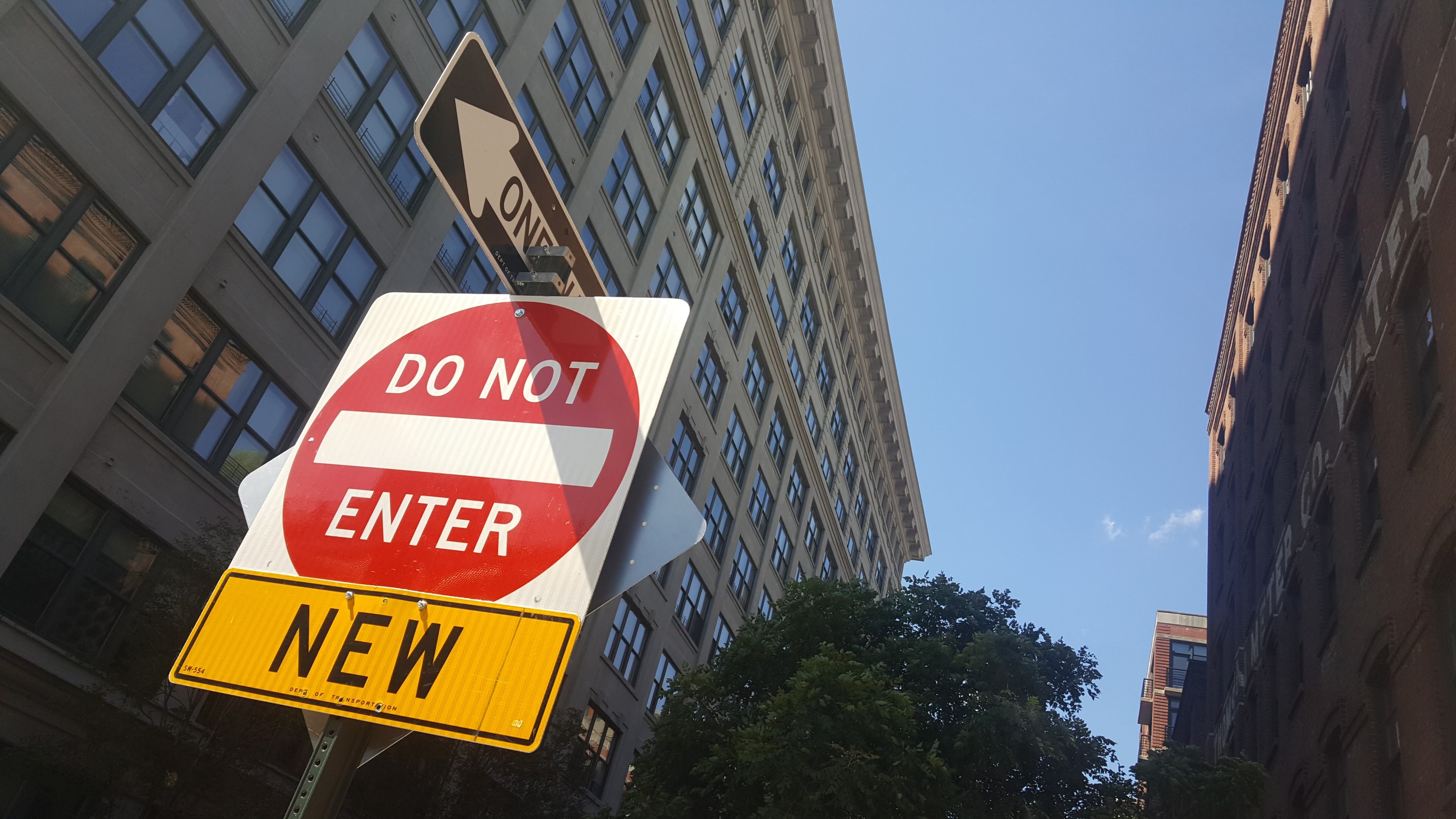Pedestrian-packed and car-clogged Washington Street in Brooklyn’s DUMBO neighborhood has been converted to a one-way between Front and York streets — a change spurred by a two-year effort by a neighborhood resident that will actually add more cars and more danger to the roadway.
As of three weeks ago, vehicles can only travel southbound on the block — or up and out of the low-lying neighborhood. There is also now metered parking on both sides of the street, effectively adding almost a dozen new parking spots to the already crowded corridor. The block had been two-way since 2010.

The change was quietly made by the Department of Transportation, nearly two years after DUMBO resident Jamel Talbi approached his community board to argue for a change on the roadway, which, at 30 feet wide, is 10 feet narrower than most two-lane streets. Talbi said that even though parking was banned on one side of the block, illegal parking persisted. The selfish drivers caused standstill traffic that created dangerous situations for all road users.
“It was a broad effort — I just happened to have been at the center of it,” Talbi told Streetsblog. “You just walk out onto the street for the umpteenth time and try to unload your child from the car seat, or even your groceries, and it was just madness on Washington.
“It is still busy, it is still dangerous, but it is much improved," he added.
But has one solved problem created several new problems? Talbi's issue has been fixed: two-way car traffic will no longer get gummed up due to illegal parking. However, with vehicles now legally parked on each side of the street, the road becomes impassable when a vehicle inevitably double-parks. Add bicyclists and pedestrians into the mix and you still have a recipe for danger. Plus, the one-way street means that one of the main bike routes into DUMBO is now more dangerous. Cyclists from Downtown Brooklyn — and those exiting the Brooklyn Bridge bike path — often used Washington Street to legally head into DUMBO's core. Now they face a "Do Not Enter" sign — and no place to ride into the neighborhood legally.
“This turns a street that could barely handle having two travel lanes and two parking lanes into a regular, narrow one-way street,” said Brian Howald, a member of Brooklyn Community Board 2, which had approved the project overwhelmingly with little debate. “The same potential for double-parking exists because there is a substantial amount of commercial businesses on that block that need loading and unloading from trucks.”

Howald said whatever upside the change may have is more than offset by the downsides.
“My main concern is that making that block one-way southbound is that it forces all traffic heading north on Washington Street to have to make a left turn at York Street,” he said. “That left turn is in the face of oncoming traffic. It’s also an intersection where the sight lines are incredibly limited due to the BQE passing overhead.
“The resident who proposed the change argued that it was safety project, but I don’t think DOT has shown any data suggesting that’s true,” Howald added. “I also don’t think any studies on one-vs.-two way streets suggest one-way streets are any safer.”
Talbi argues the problems on his block are symptomatic of the entire neighborhood. He said the major issue in DUMBO is that massive growth in the business, tourism and residential sectors hasn’t been met by policies to effectively manage the increase in foot and vehicular traffic. On this, there is widespread agreement.
“Everyone wants a piece of the gold rush that is DUMBO, which is great, but it needs to be better managed,” he said. “Right now, it’s the Wild Wild West out here.”
Talbi argues that better management would include improved enforcement of parking violations. Melissa Prober, the co-chairwoman of a local advocacy group DUMBO Action Committee, says that no one is focused on protecting pedestrians.
“For years, there were people who fought to protect the Belgian blocks in DUMBO,” Prober said. “We all love the Belgian blocks. But nobody has fought for safe streets for the pedestrians and bikers who live, work and visit DUMBO. There’s been no focus on protecting the people, and that needs to change.”
Will it? DUMBO might have become the perfect test case for a car-free neighborhood, thanks to its configuration as basically a big cul-de-sac, and its former guise as a haven for artists, cheap loft renters, squatters and industry. Even as the neighborhood started to develop, car ownership was low. But the more recent development of several large skyscrapers have brought even wealthier people — and parking lots — to the neighborhood. Those parking lots — and the dozen new spaces on Talbi's block — have created an entrenched, and now entitled, car-owning minority. Studies, after all, show that the creation of new parking tends to lead to an increase in local car ownership and use.
Meanwhile, DUMBO cultural attractions and Brooklyn Bridge Park has been drawing more and more tourists, who turn Washington Street in to a de facto pedestrian zone as they pose for artsy shots of the Empire State Building perfectly framed inside a Manhattan Bridge archway.
“DUMBO is a prime candidate for being a car-free or car-lite part of the city, because of all the pedestrians,” Howald said. “But while our peer cities in Europe and other parts of the world are finding ways to make their downtown cores car-free, the current administration doesn’t seem to be even considering those issues.”
Mayor de Blasio has consistently told Streetsblog he is not interested in following the leads of London, Paris, Madrid and other world capitals by creating neighborhood-wide pedestrian zones.






